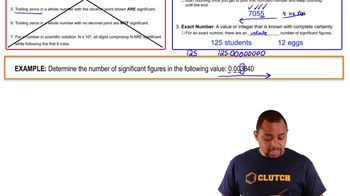On a new Jekyll temperature scale, water freezes at 17 °J and boils at 97 °J. On another new temperature scale, the Hyde scale, water freezes at 0 °H and boils at 120 °H. If methyl alcohol boils at 84 °H, what is its boiling point on the Jekyll scale?

Why does a temperature measurement of 25 °C have three significant figures, while a temperature measurement of -196 °C only has two significant figures? Explain.
 Verified step by step guidance
Verified step by step guidanceKey Concepts
Significant Figures

Temperature Measurement

Rounding Rules

Force is defined as mass times acceleration. Starting with SI base units, derive a unit for force. Using SI prefixes, suggest a convenient unit for the force resulting from a collision with a 10-ton trailer truck moving at 55 mi per hour and for the force resulting from the collision of a molecule of mass around 10 - 20 kg moving almost at the speed of light (3×108 m/s) with the wall of its container. (Assume a 1-second deceleration time for both collisions.)
The value of the euro was recently \$1.15 U.S., and the price of 1 liter of gasoline in France is 1.42 euro. What is the price of 1 gallon of gasoline in U.S. dollars in France?
A thief uses a can of sand to replace a solid gold cylinder that sits on a weight-sensitive, alarmed pedestal. The can of sand and the gold cylinder have exactly the same dimensions (length = 22 and radius = 3.8 cm). a. Calculate the mass of each cylinder (ignore the mass of the can itself). (density of gold = 19.3 g/cm3, density of sand = 3.00 g/cm3) b. Does the thief set off the alarm? Explain.
